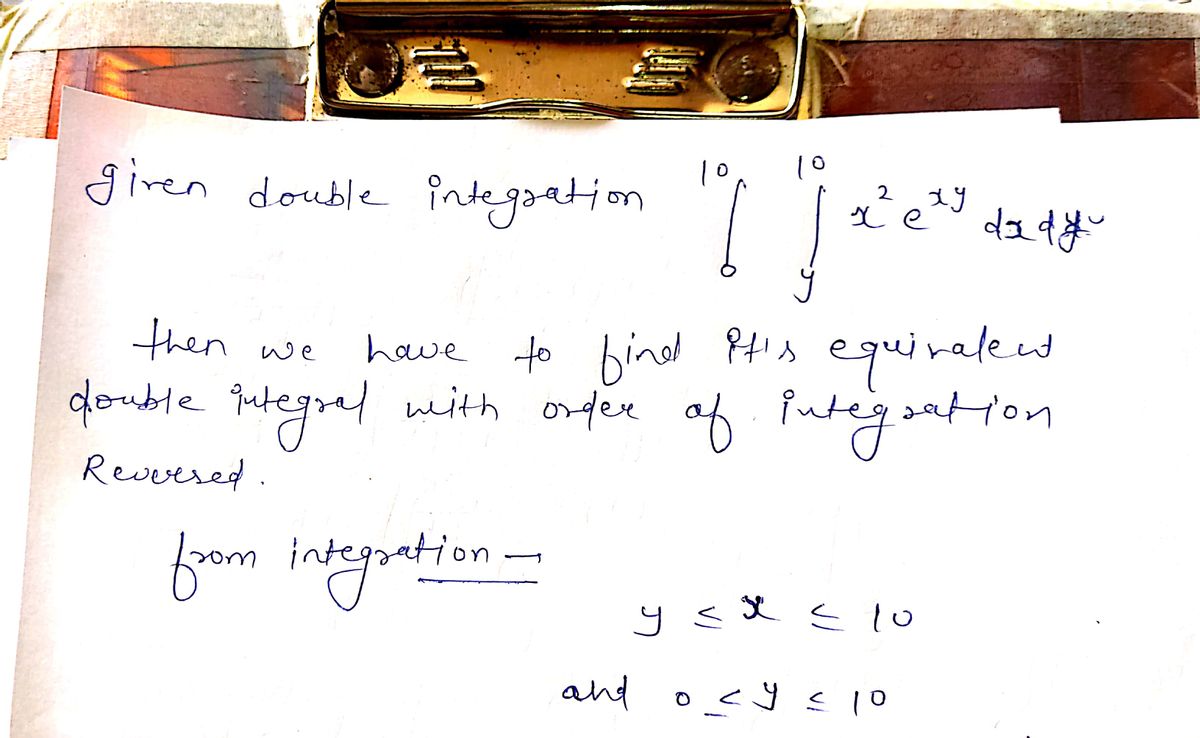Calculus: Early Transcendentals
8th Edition
ISBN:9781285741550
Author:James Stewart
Publisher:James Stewart
Chapter1: Functions And Models
Section: Chapter Questions
Problem 1RCC: (a) What is a function? What are its domain and range? (b) What is the graph of a function? (c) How...
Related questions
Question
100%
![**Topic: Equivalent Double Integral with Reversed Order of Integration**
**Objective:**
To understand how to reverse the order of integration for a given double integral.
**Question:**
What is an equivalent double integral with the order of integration reversed?
**Diagram Explanation:**
In the diagram, there is a right triangle labeled as region \( R \) on a coordinate plane. Both the x-axis and y-axis range from 0 to 15.
**Functional Representation:**
- The original double integral is given by:
\[
\int_0^{10} \int_2^y x \, e^{xy} \, dx \, dy
\]
- The reversed order of integration is:
\[
\int_2^{10} \int_y^{10} x \, e^{xy} \, dy \, dx
\]
The limits of integration are adjusted to change the order from \( dx \, dy \) to \( dy \, dx \).
**Note:**
When reversing the order of integration, ensure the limits correspond to the region \( R \) correctly, covering the same area in the plane.](/v2/_next/image?url=https%3A%2F%2Fcontent.bartleby.com%2Fqna-images%2Fquestion%2F12c62ea9-2423-4a35-a6cd-74646c6bbd41%2Ffd45a66e-3005-4fa7-a83e-8b9003617e4e%2Fx60oane_processed.jpeg&w=3840&q=75)
Transcribed Image Text:**Topic: Equivalent Double Integral with Reversed Order of Integration**
**Objective:**
To understand how to reverse the order of integration for a given double integral.
**Question:**
What is an equivalent double integral with the order of integration reversed?
**Diagram Explanation:**
In the diagram, there is a right triangle labeled as region \( R \) on a coordinate plane. Both the x-axis and y-axis range from 0 to 15.
**Functional Representation:**
- The original double integral is given by:
\[
\int_0^{10} \int_2^y x \, e^{xy} \, dx \, dy
\]
- The reversed order of integration is:
\[
\int_2^{10} \int_y^{10} x \, e^{xy} \, dy \, dx
\]
The limits of integration are adjusted to change the order from \( dx \, dy \) to \( dy \, dx \).
**Note:**
When reversing the order of integration, ensure the limits correspond to the region \( R \) correctly, covering the same area in the plane.
Expert Solution
Step 1

Step by step
Solved in 2 steps with 2 images

Recommended textbooks for you

Calculus: Early Transcendentals
Calculus
ISBN:
9781285741550
Author:
James Stewart
Publisher:
Cengage Learning

Thomas' Calculus (14th Edition)
Calculus
ISBN:
9780134438986
Author:
Joel R. Hass, Christopher E. Heil, Maurice D. Weir
Publisher:
PEARSON

Calculus: Early Transcendentals (3rd Edition)
Calculus
ISBN:
9780134763644
Author:
William L. Briggs, Lyle Cochran, Bernard Gillett, Eric Schulz
Publisher:
PEARSON

Calculus: Early Transcendentals
Calculus
ISBN:
9781285741550
Author:
James Stewart
Publisher:
Cengage Learning

Thomas' Calculus (14th Edition)
Calculus
ISBN:
9780134438986
Author:
Joel R. Hass, Christopher E. Heil, Maurice D. Weir
Publisher:
PEARSON

Calculus: Early Transcendentals (3rd Edition)
Calculus
ISBN:
9780134763644
Author:
William L. Briggs, Lyle Cochran, Bernard Gillett, Eric Schulz
Publisher:
PEARSON

Calculus: Early Transcendentals
Calculus
ISBN:
9781319050740
Author:
Jon Rogawski, Colin Adams, Robert Franzosa
Publisher:
W. H. Freeman


Calculus: Early Transcendental Functions
Calculus
ISBN:
9781337552516
Author:
Ron Larson, Bruce H. Edwards
Publisher:
Cengage Learning